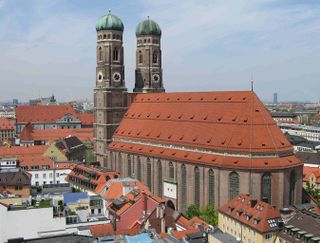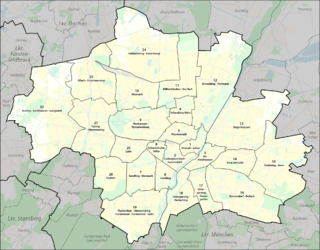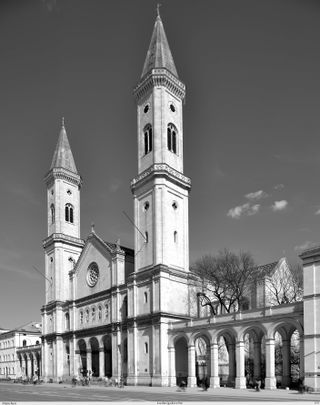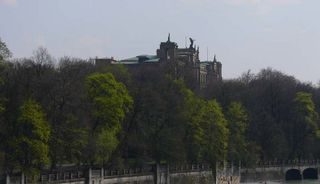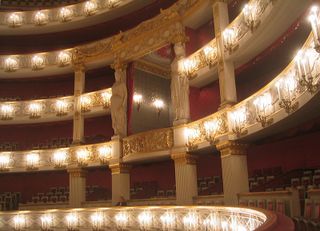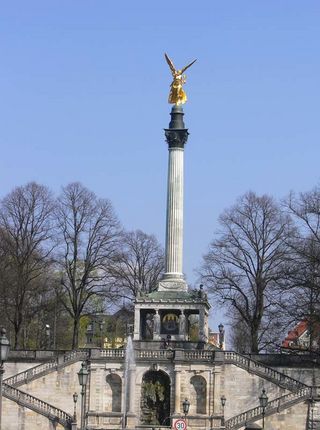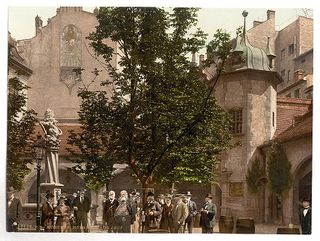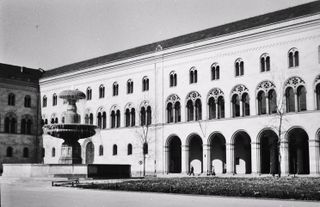Munich (München in Englisch): Unterschied zwischen den Versionen
K (→Nightlife: Link korrigiert) |
KKeine Bearbeitungszusammenfassung |
||
| (7 dazwischenliegende Versionen von 3 Benutzern werden nicht angezeigt) | |||
| Zeile 11: | Zeile 11: | ||
==History== | ==History== | ||
===Origin as medieval town=== | ===Origin as medieval town=== | ||
The year [[1158]] is assumed to be the foundation date, which is only the earliest date the city is mentioned in a document. The document was signed in | The year [[1158]] is assumed to be the foundation date, which is only the earliest date the city is mentioned in a document. The document was signed in {{WL2|en:Augsburg|Augsburg}}. By that time the Guelph Henry the Lion, Duke of Saxony and Bavaria, had built a bridge over the river Isar next to a settlement of Benedictine monks—this was on the Old Salt Route and a toll bridge. | ||
In [[1175]], Munich was officially granted city status and received fortification. In 1180, with the trial of Henry the Lion, Otto I Wittelsbach became Duke of Bavaria and Munich was handed over to the Bishop of [[Freising]]. (Wittelsbach's heirs, the [[Wittelsbacher|Wittelsbach dynasty]], would rule Bavaria until 1918.) In [[1240]], Munich was transferred to Otto II Wittelsbach and in 1255, when the [[Herzogtum Bayern|Duchy of Bavaria]] was split in two parts, Munich became the ducal residence of [[Oberbayern|Upper Bavaria]]. | In [[1175]], Munich was officially granted city status and received fortification. In 1180, with the trial of Henry the Lion, Otto I Wittelsbach became Duke of Bavaria and Munich was handed over to the Bishop of [[Freising]]. (Wittelsbach's heirs, the [[Wittelsbacher|Wittelsbach dynasty]], would rule Bavaria until 1918.) In [[1240]], Munich was transferred to Otto II Wittelsbach and in 1255, when the [[Herzogtum Bayern|Duchy of Bavaria]] was split in two parts, Munich became the ducal residence of [[Oberbayern|Upper Bavaria]]. | ||
| Zeile 299: | Zeile 299: | ||
==Transportation== | ==Transportation== | ||
===Munich International Airport=== | ===Munich International Airport=== | ||
[[Flughafen München Franz Josef Strauß|Franz Josef Strauss International Airport]] (IATA: '''[[Flughafen München Franz Josef Strauß|M U C]]''', ICAO: EDDM) is the second-largest airport in Germany and -largest in Europe after London Heathrow, Paris Charle de Gaulle, Frankfurt, Amsterdam, Madrid and | [[Flughafen München Franz Josef Strauß|Franz Josef Strauss International Airport]] (IATA: '''[[Flughafen München Franz Josef Strauß|M U C]]''', ICAO: EDDM) is the second-largest airport in Germany and -largest in Europe after London Heathrow, Paris Charle de Gaulle, Frankfurt, Amsterdam, Madrid and İstanbul. It is used by about 34 million passengers a year, and lies some 30 km north east of the city centre. The airport can be reached by suburban train lines '''S8''' from the east and '''S1''' from the west of the city. From the [[Hauptbahnhof|main railway station]] the journey takes 40–45 minutes. An express train will be added that will cut down travel time to 20–25 minutes with limited stops on dedicated tracks. A magnetic levitation train (called Transrapid) which was to have run at speeds of up to 400 km/h from the central station to the airport in a travel time of 10 minutes had been approved, but was cancelled in March 2008 because of cost escalation and after heavy protests. Lufthansa opened its second hub at the airport when Terminal 2 was opened in 2003. | ||
The airport began operations in 1992, replacing the former main airport, the [[Flughafen Riem|Munich-Riem airport]] (active 1939–1992). | The airport began operations in 1992, replacing the former main airport, the [[Flughafen Riem|Munich-Riem airport]] (active 1939–1992). | ||
== Other airports == | |||
In 2008, the Bavarian state government granted a license to expand ''Oberpfaffenhofen Air Station'' located west of Munich, for commercial use. These plans were opposed by many residents in the Oberpfaffenhofen area as well as other branches of local Government, including the city of Munich, which took the case to court. However, in October 2009, the permit allowing up to 9725 business flights per year to depart from or land at Oberpfaffenhofen was confirmed by a regional judge. | In 2008, the Bavarian state government granted a license to expand ''Oberpfaffenhofen Air Station'' located west of Munich, for commercial use. These plans were opposed by many residents in the Oberpfaffenhofen area as well as other branches of local Government, including the city of Munich, which took the case to court. However, in October 2009, the permit allowing up to 9725 business flights per year to depart from or land at Oberpfaffenhofen was confirmed by a regional judge. | ||
Despite being 110 kilometres from Munich, [[Flughafen Memmingen München West|Memmingen Airport]] has been advertised as ''Airport Munich West''. After 2005, passenger traffic of nearby Augsburg Airport was relocated to Munich Airport, leaving the Augsburg region of Bavaria without an air passenger airport within close reach. | Despite being 110 kilometres from Munich, [[Flughafen Memmingen München West|Memmingen Airport]] has been advertised as ''Airport Munich West''. After 2005, passenger traffic of nearby Augsburg Airport was relocated to Munich Airport, leaving the Augsburg region of Bavaria without an air passenger airport within close reach. | ||
== Public transportation == | |||
For its urban population of 2.6 million people, Munich and its closest suburbs have one of the most comprehensive and punctual systems in the world, incorporating the [[U-Bahn|Munich U-Bahn (underground railway)]], the [[S-Bahn|Munich S-Bahn (suburban trains)]],[[Tram|Tramtrains]] and [[Bus|buses]]. The system is supervised by the [[MVV|Transport and Tarif Association]] (''Münchner Verkehrs- und Tarifverbund GmbH''). The [[Tram|Munich tramway]] is the oldest existing public transportation system in the city, which has been in operation since 1876. Munich also has an extensive network of bus lines. | For its urban population of 2.6 million people, Munich and its closest suburbs have one of the most comprehensive and punctual systems in the world, incorporating the [[U-Bahn|Munich U-Bahn (underground railway)]], the [[S-Bahn|Munich S-Bahn (suburban trains)]],[[Tram|Tramtrains]] and [[Bus|buses]]. The system is supervised by the [[MVV|Transport and Tarif Association]] (''Münchner Verkehrs- und Tarifverbund GmbH''). The [[Tram|Munich tramway]] is the oldest existing public transportation system in the city, which has been in operation since 1876. Munich also has an extensive network of bus lines. | ||
| Zeile 322: | Zeile 319: | ||
The trade fair transport logistic is held every two years at the ''Neue Messe München'' (Messe München International). | The trade fair transport logistic is held every two years at the ''Neue Messe München'' (Messe München International). | ||
== Individual transportation == | |||
[[File:Mariensaeule1885a.jpg|thumb|right|The [[Mariensäule (Marienplatz)|Mariensäule]] (Mary's column)]] | [[File:Mariensaeule1885a.jpg|thumb|right|The [[Mariensäule (Marienplatz)|Mariensäule]] (Mary's column)]] | ||
Munich is an integral part of the [[Autobahn|motorway]] network of southern Germany. Motorways from Stuttgart (W), Nuremberg, Frankfurt and Berlin (N), Deggendorf and Passau (E), Salzburg and Innsbruck (SE), Garmisch Partenkirchen (S) and Lindau (SW) terminate at Munich, allowing direct access to the different parts of Germany, Austria and Italy. However, traffic in and around Munich is often heavy. Traffic jams are commonplace during rush hour and at the beginning and end of major holidays in Germany. | Munich is an integral part of the [[Autobahn|motorway]] network of southern Germany. Motorways from Stuttgart (W), Nuremberg, Frankfurt and Berlin (N), Deggendorf and Passau (E), Salzburg and Innsbruck (SE), Garmisch Partenkirchen (S) and Lindau (SW) terminate at Munich, allowing direct access to the different parts of Germany, Austria and Italy. However, traffic in and around Munich is often heavy. Traffic jams are commonplace during rush hour and at the beginning and end of major holidays in Germany. | ||
== Cycling == | |||
Cycling is recognized as a good alternative to motorized transport and the growing number of bicycle lanes are widely used throughout the year. They are mostly not segregated from pedestrian paths, making them dangerous to both parties. They are also often of low quality surfacing, being partly destroyed by the roots of trees planted between them and the road beside it; the road is rarely so affected. The narrow paths which are usually longer than the road due to many detours around objects, coupled with the presence of pedestrians, make the cycle network useful only to very slow riders. | Cycling is recognized as a good alternative to motorized transport and the growing number of bicycle lanes are widely used throughout the year. They are mostly not segregated from pedestrian paths, making them dangerous to both parties. They are also often of low quality surfacing, being partly destroyed by the roots of trees planted between them and the road beside it; the road is rarely so affected. The narrow paths which are usually longer than the road due to many detours around objects, coupled with the presence of pedestrians, make the cycle network useful only to very slow riders. | ||
| Zeile 342: | Zeile 339: | ||
*[[Verona]], Italy <small>''(1960)''</small> | *[[Verona]], Italy <small>''(1960)''</small> | ||
*[[Bordeaux]], France <small>''(1964)''</small> | *[[Bordeaux]], France <small>''(1964)''</small> | ||
* | *{{WL2|Sapporo}}, Japan <small>''(1972)''</small> | ||
*[[Cincinnati]], Ohio, United States <small>''(1989)''</small> | *[[Cincinnati]], Ohio, United States <small>''(1989)''</small> | ||
*[[Kiew|Kiev]], Ukraine <small>''(1989)''</small> | *[[Kiew|Kiev]], Ukraine <small>''(1989)''</small> | ||
* | *{{WL2|Harare}}, Zimbabwe <small>''(1996)''</small> | ||
* Munich, München is also the name of other locations, look for: [[München (Begriffsklärung)]] | * Munich, München is also the name of other locations, look for: [[München (Begriffsklärung)]] | ||
| Zeile 493: | Zeile 489: | ||
*[http://www.flickr.com/groups/talesfromtoytown/pool Tales from Toytown] – Photos of Munich | *[http://www.flickr.com/groups/talesfromtoytown/pool Tales from Toytown] – Photos of Munich | ||
*[http://www.itravelnet.com/photography/europe/germany/munichphotogallery.html Munich photo gallery] | *[http://www.itravelnet.com/photography/europe/germany/munichphotogallery.html Munich photo gallery] | ||
; Book: very simple, easy to read | |||
* [[Rüdiger_Liedtke]] - ''111 Places in Munich That You Shouldn’t Miss'' [https://www.emons-verlag.com/programm/111-places-in-munich-that-you-shouldnt-miss (edition)] | |||
== Source (am-en-fr) == | == Source (am-en-fr) == | ||
| Zeile 498: | Zeile 497: | ||
(in ihrer englischsprachigen Ausgabe mit dem Textbestand vom Mai 2013) | (in ihrer englischsprachigen Ausgabe mit dem Textbestand vom Mai 2013) | ||
== Munich - französisch ausgesprochen== | |||
*Siehe bei WP: [https://fr.wikipedia.org/wiki/Munich '''fr.wikipedia.'''.. Munich] | |||
===… and === | ===… and === | ||
*[http://simple.wikipedia.org/wiki/Munich Munich in der Wikipedia auf vereinfachtem Englisch] (Simple English) | *[http://simple.wikipedia.org/wiki/Munich Munich in der Wikipedia auf vereinfachtem Englisch] (Simple English) | ||
| Zeile 504: | Zeile 505: | ||
*[[Munich Fast Facts]] | *[[Munich Fast Facts]] | ||
[[Kategorie: | [[Kategorie:Stadt München|* | ||
[[Kategorie:Geschichte]] | [[Kategorie:Geschichte]] | ||
[[Kategorie: | [[Kategorie:Geographie]] | ||
[[Kategorie:Englisch| ]] | [[Kategorie:Englisch| ]] | ||
Aktuelle Version vom 13. Oktober 2023, 15:38 Uhr
München - Munich (/ˈmjuːnɪk/; German: München, pronounced [ˈmʏnçən], Bavarian: Minga) is the capital and the largest city of the German state of Bavaria. It is located on the river Isar north of the Bavarian Alps. Munich is the third largest city in Germany, behind Berlin and Hamburg. About 1.42 million people live within the city limits. Munich was the host city of the 1972 Summer Olympics. Its inhabitants are sometimes called Munichers in English.
The city's motto is "München mag dich" (Munich likes you). Before 2006, it was "Weltstadt mit Herz" (Cosmopolitan city with a heart). Its native name München is derived from the Old High German Munichen, meaning "by the monks' place". The city's name derives from the monks of the Benedictine order, who founded the city; hence the monk depicted on the city's coat of arms. Black and gold — the colours of the Holy Roman Empire — have been the city's official colours since the time of Ludwig the Bavarian.
Modern Munich is a financial and publishing hub and a frequently top-ranked destination for migration and expatriate location in livability rankings. Munich achieved 4th place in frequently quoted |Mercer livability rankings in 2011 and 2012. For economic and social innovation, the city was ranked 15th globally out of 289 cities in 2010, and 5th in Germany by the 2thinknow Innovation Cities Index based on analysis of 162 indicators In 2010, Monocle ranked Munich as the world's most livable city in 2012, Munich was ranked fifth in Monocle's ranking, yet remained the highest ranked city in Germany).
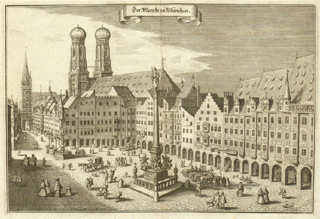
History
Origin as medieval town
The year 1158 is assumed to be the foundation date, which is only the earliest date the city is mentioned in a document. The document was signed in AugsburgW. By that time the Guelph Henry the Lion, Duke of Saxony and Bavaria, had built a bridge over the river Isar next to a settlement of Benedictine monks—this was on the Old Salt Route and a toll bridge.
In 1175, Munich was officially granted city status and received fortification. In 1180, with the trial of Henry the Lion, Otto I Wittelsbach became Duke of Bavaria and Munich was handed over to the Bishop of Freising. (Wittelsbach's heirs, the Wittelsbach dynasty, would rule Bavaria until 1918.) In 1240, Munich was transferred to Otto II Wittelsbach and in 1255, when the Duchy of Bavaria was split in two parts, Munich became the ducal residence of Upper Bavaria.
Duke Louis IV was elected German king in 1314 and crowned as Holy Roman Emperor in 1328. He strengthened the city's position by granting it the salt monopoly, thus assuring it of additional income. In the late 15th century Munich underwent a revival of gothic arts—the Old Town Hall was enlarged, and Munich's largest gothic church, now a cathedral—the Frauenkirche—constructed in only twenty years, starting in 1468.
Capital of reunited Bavaria
When Bavaria was reunited in 1506, Munich became its capital. The arts and politics became increasingly influenced by the court (see Orlando di Lasso, Heinrich Schuetz and later Mozart and Richard Wagner). During the 16th century Munich was a centre of the German counter reformation, and also of renaissance arts. Duke Wilhelm V. commissioned the Jesuit Michaelskirche, which became a centre for the counter-reformation, and also built the Hofbräuhaus for brewing brown beer in 1589.
The Catholic League was founded in Munich in 1609.
In 1623 during the Thirty Years' War Munich became electoral residence when Maximilian I, Duke of Bavaria was invested with the electoral dignity, but in 1632 the city was occupied by Gustav II Adolph of Sweden. When the bubonic plague broke out in 1634 and 1635 about one third of the population died. Under the regency of the Bavarian electors Munich was an important centre of baroque life but also had to suffer under Habsburg occupations in 1704 and 1742.
In 1806, the city became the capital of the new Kingdom of Bavaria, with the state's parliament (the Landtag) and the new archdiocese of Munich and Freising being located in the city. Twenty years later Landshut University was moved to Munich. Many of the city's finest buildings belong to this period and were built under the first three Bavarian kings. Later Prince Regent Luitpold's years as regent were marked by tremendous artistic and cultural activity in Munich (see Franz von Stuck and Der Blaue Reiter).
World War I to World War II
Following the outbreak of World War I in 1914, life in Munich became very difficult, as the Allied blockade of Germany led to food and fuel shortages. During French air raids in 1916, three bombs fell on Munich.
After World War I, the city was at the centre of much political unrest. In November 1918 on the eve of revolution, Ludwig III and his family fled the city. After the murder of the first republican premier of Bavaria Kurt Eisner in February 1919 by Anton Graf von Arco auf Valley, the Bavarian Soviet Republic was proclaimed. When Communists had taken power, Lenin, who had lived in Munich some years before, sent a congratulatory telegram, but the Soviet Republic was put down on 3 May 1919 by the Freikorps. While the republican government had been restored, Munich subsequently became a hotbed of extremist politics, among which Adolf Hitler and the National Socialism rose to prominence.
In 1923 monarchists and nationalists, who were then concentrated in Munich, staged the Beer Hall Putsch (Gen. Ludendorff, Hitler a. o.), an attempt to overthrow the Weimar Republic and seize power. The revolt failed at the Feldherrenhalle, resulting in Hitler's arrest and the temporary crippling of the Nazi Party, which was virtually unknown outside Munich.
The city once again became a Nazi stronghold when the Nazis took power in Germany in 1933. The National Socialist Workers Party created the first concentration camp at Dachau, 10 miles (16 km) north-west of the city. Because of its importance to the rise of National Socialism, Munich was referred to as the Hauptstadt der Bewegung ("Capital of the Movement"). The NSDAP headquarters was in Munich and many Führerbauten ("leader-buildings") were built around the Königsplatz, some of which have survived to this day.
The city is known as the site of the culmination of the policy of appeasement employed by Britain and France leading up to World War II. It was in Munich that British Prime Minister Neville Chamberlain assented to the annexation of Czechoslovakia's Sudetenland region into Greater Germany in the hopes of sating the desires of Hitler's Third Reich.
Munich was also the base of some resistance like the White Rose, a student resistance movement from June 1942 to February 1943. The core members were arrested and executed following a distribution of leaflets in Munich University by Hans and Sophie Scholl.
The city was heavily damaged by allied bombing during World War II — the city was hit by 74 air raids over a period of six years.
- Concentration Camp Memorial Dachau Concentration Camp Memorial Site - A Tour
Postwar
After US occupation in 1945, Munich was completely rebuilt following a meticulous and—by comparison to other war-ravaged West German cities—rather conservative plan which preserved its pre-war street grid. In 1957 Munich's population passed the 1 million mark.
Munich was the site of the 1972 Summer Olympics, during which Israeli athletes were assassinated by Palestinian fedayeen in the Munich massacre, when gunmen from the Palestinian "Black September" group took hostage members of the Israeli Olympic team.
Most Munich residents enjoy a high quality of life. Mercer HR Consulting consistently rates the city among the top 10 cities with the highest quality of life worldwide—a 2011 survey ranked Munich as 4th.[1] The same company also ranks Munich as the world's 39th most expensive city to live in and the most expensive major city in Germany.[2] Munich enjoys a thriving economy, driven by the information technology, biotechnology, and publishing sectors. Environmental pollution is low, although as of 2006 the city council is concerned about levels of particulate matter (PM), especially along the city's major thoroughfares. Since the enactment of EU legislation concerning the concentration of particulate in the air, environmental groups such as Greenpeace have staged large protest rallies to urge the city council and the State government to take a harder stance on pollution.
Today, the crime rate is low compared to other large German cities, such as Hamburg or Berlin. This high quality of life and safety has caused the city to be nicknamed "Toytown" among the English-speaking residents. German inhabitants call it "Millionendorf", an expression which means "village of a million people".
Geography
Munich lies on the elevated plains of Upper Bavaria, about 50 km north of the northern edge of the Alps, at an altitude of about 520 m above mean sea level. The local rivers are the Isar and the Würm.
Munich is situated in the Northern Alpine Foreland. The northern part of this sandy plateau includes a highly fertile flint area which is no longer affected by the folding processes found in the Alps, while the southern part is covered with morainic hills. Between these are fields of fluvio-glacial out-wash, such as around Munich. Wherever these deposits get thinner, the ground water can permeate the gravel surface and flood the area, leading to marshes as in the north of Munich.
Climate
The city of Munich is classified in the Köppen classification as Cfb/Dfb (Oceanic/Humid continental climate). It is almost directly on the edge of two classifications, however, with the Dfb (Humid Continental Warm Summer Subtype) climate zone just to the east of the city.
The warmest month of the year, on average, is July. The coolest month of the year, on average, is January.
Showers and thunderstorms bring the highest average monthly precipitation totals in late spring and throughout the summer. June, on average, records the most precipitation of any month. The winter months tend to bring lower precipitation, on average, and February averages the least amount of monthly precipitation for the year.
The higher elevation of Munich and the proximity of the Alps play a significant role on the climate, causing the city to have more rain and snow than many other parts of Germany. The Alps affect the city's climate in other ways, as well, including a warm downhill wind from the Alps (föhn wind), which can raise temperatures sharply within a few hours, even in the winter.
The location of Munich at the center of Europe dictates that many climatic factors impact the city, making for fluctuating weather conditions more often than in other locations on the continent, particularly compared with areas further west and those south of the Alps.
At Munich's official weather station, the highest and lowest temperatures ever measured are 37.1 C˚, on August 13, 2003, and -30.5 C˚, on January 21, 1942.
Demographics
In July 2007, Munich had 1.34 million inhabitants; 300,129 of those did not hold German citizenship. The city has strong Turkish and Balkan communities. The largest groups of foreign nationals were Turks (43,309), Albanians (30,385), Croats (24,866), Serbs (24,439), Greeks (22,486), Austrians (21,411), and Italians (20,847). 37% of foreign nationals come from the European Union.
With 24,000 inhabitants in 1700, the population doubled about every 30 years. For example, it had 100,000 people in 1852 and then 250,000 people in 1883; by 1901, the figure had doubled again to 500,000. Since then, Munich has become Germany's third largest city. In 1933, 840,901 inhabitants were counted and in 1957, Munich's population passed the 1 million mark.

49.3% of Munich's residents are not affiliated with any religious group, and this ratio represents the fastest growing segment of the population. As in the rest of Germany, the Roman Catholic and Protestant churches have experienced a continuous, slow decline in their memberships. As of 31 December 2010, 36.8% of the city's inhabitants were Roman Catholic, 13.6% Protestant, and 0.3% Jewish. There is also a small Old Catholic parish and an English-speaking parish of the Episcopal Church in the city. There are also a significant number of Muslims living in Munich, most of them immigrants.
Politics
Munich's current mayor is Dieter Reiter of the Social Democratic Party of Germany. Munich had mayors of the SPD for all but six years since 1948. This is remarkable because Bavaria—and particularly southern Bavaria—has long been a conservative stronghold, with the Christian Social Union winning overall majorities among the Bavarian electorate in many elections at the communal, state, and federal levels. Bavaria's second city, Nuremberg, is also one of the few Bavarian cities governed by a SPD-led coalition.
Munich is currently governed by a coalition of the CSU and the SPD, after a longtime coalition between SPD, the Greens and several smaller groups.
As the capital of the Free State of Bavaria, Munich is an important political centre in Germany and the seat of the Bavarian State Parliament, the Staatskanzlei (the State Chancellery) and of all state departments.
Several national and international authorities are located in Munich, including the Federal Finance Court of Germany and the European Patent Office.
Subdivisions
Since the administrative reform in 1992, Munich is divided into 25 boroughs, the Stadtbezirke.
Allach-Untermenzing (23), Altstadt-Lehel (1), Aubing-Lochhausen-Langwied (22), Au-Haidhausen (5), Berg am Laim (14), Bogenhausen (13), Feldmoching-Hasenbergl (24), Hadern (20), Laim (25), Ludwigsvorstadt-Isarvorstadt (2), Maxvorstadt (3), Milbertshofen-Am Hart (11), Moosach (10), Neuhausen-Nymphenburg (9), Obergiesing (17), Pasing-Obermenzing (21), Ramersdorf-Perlach (16), Schwabing-Freimann (12), Schwabing-West (4), Schwanthalerhöhe (8), Sendling (6), Sendling-Westpark (7), Thalkirchen-Obersendling-Forstenried-Fürstenried-Solln (19), Trudering-Riem (15) and Untergiesing-Harlaching (18).
Architecture
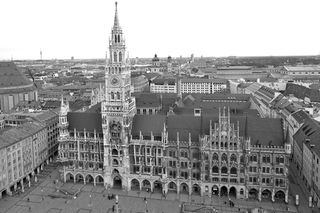
The city is an inspiring mix of historic buildings and impressive architecture, since Munich reconstructed the ruins of their historic buildings but also created new landmarks of architecture. A survey, conducted by the Society's Center for Sustainable Destinations for the National Geographic Traveler, chose over 100 historic places around the world and ranked Munich as the 30th best destination.
The inner city
At the centre of the city is the Marienplatz — a large open square named after the Mariensäule, a Marian column in its centre—with the Old and the New Town Hall. Its tower contains the Rathaus-Glockenspiel. Three gates of the demolished medieval fortification have survived to this day—the Isartor in the east, the Sendlinger Tor in the south and the Karlstor in the west of the inner city. The Karlstor leads up to the Stachus, a grand square dominated by the Justizpalast (Palace of Justice) and a fountain. [[File: Nationalmuwstud2010a.jpg|thumb|left|Bavarian National Museum]] The Peterskirche close to Marienplatz is the oldest church of the inner city. It was first built during the Romanesque period, and was the focus of the early monastic settlement in Munich before the city's official foundation in 1158. Nearby St. Peter the Gothic hall-church Heiliggeistkirche (The Church of the Holy Spirit) was converted to baroque style from 1724 onwards and looks down upon the Viktualienmarkt, the most popular market of Munich.
The Frauenkirche is the most famous building in the city centre and serves as the cathedral for the Archdiocese of Munich and Freising. The nearby Michaelskirche is the largest renaissance church north of the Alps, while the Theatinerkirche is a basilica in Italianate high baroque which had a major influence on Southern German baroque architecture. Its dome dominates the Odeonsplatz. Other baroque churches in the inner city which are worth a detour are the Bürgersaalkirche, the Dreifaltigkeitskirche, the St. Anna Damenstiftskirche and St. Anna im Lehel, the first rococo church in Bavaria. The Asamkirche was endowed and built by the Brothers Asam, pioneering artists of the rococo period.
The large Residenz palace complex (begun in 1385) on the edge of Munich's Old Town ranks among Europe's most significant museums of interior decoration. Having undergone several extensions, it contains also the treasury and the splendid rococo Cuvilliés-Theater. Next door to the Residenz the neo-classical opera, the National Theatre was erected. Among the baroque and neoclassical mansions which still exist in Munich are the Palais Porcia, the Palais Preysing, the Palais Holnstein and the Prinz-Carl-Palais. All mansions are situated close to the Residenz, same as the Alte Hof, a medieval castle and first residence of the Wittelsbach dukes in Munich.
The inner city has been recreated[3] in the virtual world of Second Life and can be visited for a virtual sight seeing tour.
The royal avenues and squares
Four grand royal avenues of the 19th century with magnificent official buildings connect Munich's inner city with the suburbs:
The neoclassical Briennerstrasse, starting at Odeonsplatz on the northern fringe of the Old Town close to the Residenz, runs from east to west and opens into the impressive Königsplatz, designed with the "Doric" Propyläen, the "Ionic" Glyptothek and the "Corinthian" State Museum of Classical Art, on its back side St. Boniface's Abbey was erected. The area around Königsplatz is home to the Kunstareal, Munich's gallery and museum quarter (as described below).
Ludwigstrasse also begins at Odeonsplatz and runs from south to north, skirting the Ludwig-Maximilians-Universität, the St. Louis church, the Bavarian State Library and numerous state ministries and palaces. The southern part of the avenue was constructed in Italian renaissance style while the north is strongly influenced by Italian Romanesque architecture.
The neo-Gothic Maximilianstrasse starts at Max-Joseph-Platz, where the Residenz and the National Theatre are situated, and runs from west to east. The avenue is framed by neo-Gothic buildings which house, among others, the Schauspielhaus and the Building of the district government of Upper Bavaria and the Museum of Ethnology. After crossing the river Isar, the avenue circles the Maximilianeum, home of the state parliament. The western portion of Maximilianstraße is known for its designer shops, luxury boutiques, jewellery stores, and one of Munich's foremost five-star hotels, the Hotel Vier Jahreszeiten.
Prinzregentenstrasse runs parallel to Maximilianstraße and begins at Prinz-Carl-Palais. Many museums can be found along the avenue, such as the Haus der Kunst, the Bavarian National Museum and the Schackgalerie. The avenue crosses the Isar and circles the Friedensengel monument passing the Villa Stuck and Hitler's old apartment. The Prinzregententheater is at Prinzregentenplatz further to the east.
Other boroughs
Two large baroque palaces in Nymphenburg and Oberschleissheim are reminders of Bavaria's royal past. Schloss Nymphenburg (Nymphenburg Palace), some 6 km north west of the city centre, is surrounded by an impressive park and is considered to be one of Europe's most beautiful royal residences. 2 km north west of Nymphenburg Palace is Schloss Blutenburg (Blutenburg Castle), an old ducal country seat with a late-Gothic palace church. Schloss Fürstenried (Fürstenried Palace), a baroque palace of similar structure to Nymphenburg but of much smaller size, was erected around the same time in the south west of Munich. The second large baroque residence is Schloss Schleissheim (Schleissheim Palace), located in the suburb of Oberschleissheim, a palace complex encompassing three separate residences: Altes Schloss Schleissheim (the old palace), Neues Schloss Schleissheim (the new palace) and Schloss Lustheim (Lustheim Palace). Most parts of the palace complex serve as museums and art galleries. Deutsches Museum's Flugwerft Schleissheim flight exhibition centre is located nearby, on the Schleissheim Special Landing Field. The Grünwald castle is the only medieval castle in the Munich area which still exisists.
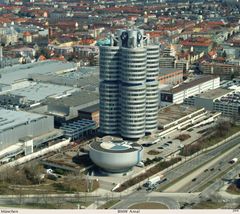
St Michael in Berg am Laim might be the most remarkable church out of the inner city. Most of the boroughs have parish churches which originate from the Middle Ages like the most famous church of pilgrimage in Munich St Mary in Ramersdorf. The oldest church within the city borders is Heilig Kreuz in Fröttmaning next to the Allianz-Arena, known for its Romanesque fresco.
Especially in its suburbs, Munich features a wide and diverse array of modern architecture, although strict culturally sensitive height limitations for buildings have limited the construction of skyscrapers to avoid a loss of views to the distant Bavarian Alps. Most high-rise buildings are clustered at the northern edge of Munich in the skyline, like the Hypo-Haus, the Arabella High-Rise Building, the Highlight Business Towers, Uptown Munich, Münchner Tor and the BMW Headquarters next to the Olympic Park. Several other high-rise buildings are located near the city centre and on the Siemens campus in southern Munich. A landmark of modern Munich is also the architecture of the sport stadiums (as described below).
In Fasangarten is the former McGraw-Kaserne, a former U.S. army base, near Stadelheim Prison.
Parks
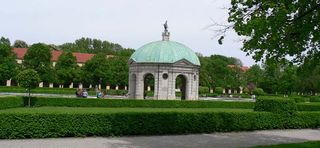
Munich is a green city with numerous parks. The Englischer Garten, close to the city centre and covering an area of 3.7 km² (larger than Central Park in New York), is one of the world's largest urban public parks, and contains a nudist area, jogging tracks and bridle-paths. It was designed and laid out by Benjamin Thompson, Count of Rumford, for both pleasure and as a work area for the city's vagrants and homeless. Nowadays it is entirely a park with a Biergarten at the Chinese Pagoda.
Other large green spaces are the modern Olympiapark, Westpark, and the parks of Nymphenburg Palace (with the Botanischer Garten München-Nymphenburg to the north), and Schleissheim Palace. The city's oldest park is the Hofgarten, near the Residenz, and dating back to the 16th century. Best known for the largest beergarden in the town is the former royal Hirschgarten, founded in 1780 for deer which still live there.
The city's zoo is the Tierpark Hellabrunn near the Flaucher Island in the Isar in the south of the city. Another notable park is Ostpark, located in Perlach-Ramersdorf area which houses the swimming area, Michaelibad, one of the largest in Munich.
Sports
Football
Munich is home to several professional football (soccer) teams including Bayern Munich, Germany's most successful club and a multiple Champions League winner. The Munich area currently has three teams (Bayern Munich], 1860 Munich and SpVgg Unterhaching) in the Bundeslig system, which comprises the three top divisions of German football.
Basketball
FC Bayern Munich Basketball currently playing in Beko Basket Bundesliga.
Hockey
The city's ice hockey club is EHC Munich.
Olympics
Munich has also hosted the 1972 Summer Olympics and was one of the host cities for the 2006 Football World Cup which was not held in Munich's Olympic Stadium but in a new football specific stadium, the Allianz Arena.
Munich bid to host the 2018 Winter Olympic Games but lost to Pyeongchang. In September 2011 the DOSB President Thomas Bach confirmed that Munich would bid again for the Winter Olympics in the future.[4]
Culture
Language
The Austro-Bavarian language is also spoken in and around Munich, with its variety Upper Bavarian (Oberbayrisch). Austro-Bavarian has no official status by the Bavarian authorities or local government yet is recognised by the SIL and has its own ISO-639 code.
Museums
The Deutsches Museum or German Museum, located on an island in the River Isar, is the largest and one of the oldest science museums in the world. Three redundant exhibition buildings which are under a protection order were converted to house the Verkehrsmuseum, which houses the land transport collections of the Deutsches Museum. Deutsches Museum's Flugwerft Schleissheim flight exhibition centre is located nearby, on the Schleissheim Special Landing Field.
Several non-centralised museums (many of those are public collections at Ludwig-Maximilians-Universität) show the expanded state collections of palaeontology, geology, mineralogy, zoology, botany and anthropology.
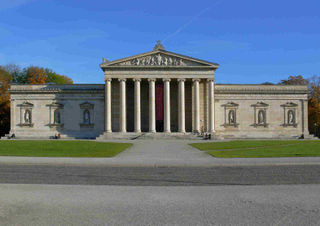
The city has several important art galleries, most of which can be found in the Kunstareal, including the Alte Pinakothek, the Neue Pinakothek, the Pinakothek der Moderne and the Museum Brandhorst. Alte Pinakothek's monolithic structure contains a treasure trove of the works of European masters between the 14th and 18th centuries. The collection reflects the eclectic tastes of the Wittelsbachs over four centuries, and is sorted by schools over two sprawling floors. Major displays include Albrecht Dürer's Christ-like Self-Portrait, his Four Apostles, Raphael's paintings The Canigiani Holy Family and Madonna Tempi as well as Peter Paul Rubens two-storey-high Judgment Day. The gallery houses one of the world's most comprehensive Rubens collections. Before World War I, the Blaue Reiter group of artists worked in Munich. Many of their works can now be seen at the Lenbachhaus.
An important collection of Greek and Roman art is held in the Glyptothek and the Staatliche Antikensammlungen (State Antiquities Collection). King Ludwig I managed to acquire such famous pieces as the Medusa Rondanini, the Barberini Faun and figures from the Temple of Aphaea on Aegina for the Glyptothek. The Kunstareal will be further augmented by the completion of the Egyptian Museum.
The famous gothic Morris dancers of Erasmus Grasser are exhibited in the Munich City Museum in the old gothic arsenal building in the inner city.
Another area for the arts next to the Kunstareal is the Lehel quarter between the old town and the river Isar: The State Museum of Ethnology in Maximilianstrasse is the second largest collection in Germany of artifacts and objects from outside Europe, while the Bavarian National Museum and the adjoining Bavarian State Archaeological Collection in Prinzregentenstrasse rank among Europe's major art and cultural history museums. The nearby Schackgalerie is an important gallery of German 19th century paintings.
The former Dachau concentration camp (1933-1945, freeed by 6th US-Army) is 16 kilometres outside the city.
Arts and literature
Munich is a major European cultural centre and has played host to many prominent composers including Orlando di Lasso, W.A. Mozart, Carl Maria von Weber, Richard Wagner, Gustav Mahler, Richard Strauss, Max Reger and Carl Orff. With the Munich Biennale founded by Hans Werner Henze, and the A*DEvantgarde festival, the city still contributes to modern music theatre.
The Nationaltheater where several of Richard Wagner's operas had their premieres under the patronage of Ludwig II of Bavaria is the home of the Bavarian State Opera and the Bavarian State Orchestra. Next door the modern Residenz Theatre was erected in the building that had housed the Cuvilliés Theatre before World War II. Many operas were staged there, including the premiere of Mozart's "Idomeneo" in 1781. The Gärtnerplatz Theatre is a ballet and musical state theatre while another opera house the Prinzregententheater has become the home of the Bavarian Theatre Academy.
The modern Gasteig center houses the Munich Philharmonic Orchestra. The third orchestra in Munich with international importance is the Bavarian Radio Symphony Orchestra. Its primary concert venue is the Herkulesaal in the former city royal residence, the Residenz. A stage for shows, big events and musicals is the Deutsche Theater. It is Germany's largest theatre for guest performances.
Next to the Bavarian Staatsschauspiel in the Residenz Theatre (Residenztheater), the Munich Kammerspiele in the Schauspielhaus is one of the most important German language theatres in the world. Since Gotthold Ephraim Lessing's premieres in 1775 many important writers have staged their plays in Munich such as Christian Friedrich Hebbel, Henrik Ibsen and Hugo von Hofmannsthal.
The city is known as the second largest publishing center in the world (around 250 publishing houses have offices in the city), and many national and international publications are published in Munich, such as Arts in Munich, LAXMag and Prinz.
Prominent literary figures worked in Munich especially during the final centuries of the Kingdom of Bavaria such as Paul Heyse, Max Halbe, Rainer Maria Rilke and Frank Wedekind.
The period immediately before World War I saw economic and cultural prominence for the city. Munich, and especially its suburb of Schwabing, became the domicile of many artists and writers. Thomas Mann, who also lived there, wrote ironically in his novella Gladius Dei about this period, "Munich shone". It remained a centre of cultural life during the Weimar period with figures such as Lion Feuchtwanger, Bertolt Brecht and Oskar Maria Graf. In 1919 the Bavaria Film Studios were founded.
From the Gothic to the Baroque era, the fine arts were represented in Munich by artists like Erasmus Grasser, Jan Polack, Johann Baptist Straub, Ignaz Günther, Hans Krumpper, Ludwig von Schwanthaler, Cosmas Damian Asam, Egid Quirin Asam, Johann Baptist Zimmermann, Johann Michael Fischer and François de Cuvilliés.
Munich had already become an important place for painters like Carl Rottmann, Lovis Corinth, Wilhelm von Kaulbach, Carl Spitzweg, Franz von Lenbach, Franz von Stuck and Wilhelm Leibl when Der Blaue Reiter (The Blue Rider), a group of expressionist artists, was established in Munich in 1911. The city was home to the Blue Rider's painters Paul Klee, Wassily Kandinsky, Alexej von Jawlensky, Gabriele Münter, Franz Marc, August Macke and Alfred Kubin.
Hofbräuhaus and Oktoberfest
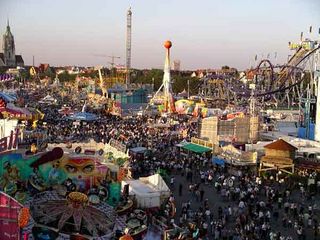
The Hofbräuhaus am Platzl, arguably the most famous beer hall worldwide, is located in the city centre. It also operates the second largest tent at the Oktoberfest, one of Munich's most famous attractions. For two weeks, the Oktoberfest attracts millions of people visiting its beer tents ("Bierzelte") and fairground attractions. The Oktoberfest was first held on 12 October 1810 in honour of the marriage of crown prince Ludwig to Princess Therese von Sachsen-Hildburghausen. The festivities were closed with a horse race and in the following years the horse races were continued and later developed into what is now known as the Oktoberfest. Despite its name, most of Oktoberfest occurs in September. It always finishes on the first Sunday in October unless the German national holiday on 3 October ("Tag der deutschen Einheit"-Day of German Unity) is a Monday or Tuesday-then the Oktoberfest remains open for these days.
Culinary specialities
The Weißwurst ('white sausage') is a Munich speciality. Traditionally eaten only before 12:00 noon — a tradition dating to a time before refrigerators — these morsels are often served with sweet mustard and freshly baked pretzels. Leberkäs, Bavarian baked sausage loaf, often served with potato salad, is another delicacy of the region.
The most famous soup might be the Leberknödel Soup. Leberknödel is a bread dumpling seasoned with liver and onions.
Schweinsbraten (pot roasted pork) with Knödel (dumplings made from potatoes or white bread) and Kraut (cabbage) or a Schweinshaxe (pork knuckle) are served as lunch or dinner. Beuscherl, a plate of lung, heart and spleen is also served with dumplings.
Popular as dessert is the Apfelstrudel (apple) strudel with vanilla sauce, the Millirahmstrudel a cream cheese strudel, Dampfnudeln (yeast dumplings served with custard) or Auszogene, a fried pastry shaped like a large donut but without a hole. And there is also the famous Prinzregententorte created in honour of the prince regent Luitpold.
Some specialities are typical cold dishes served in beergardens: Obatzda is a Bavarian cheese delicacy, a savoury blend of smashed mellow camembert prepared with cream cheese, cut onions and spicy paprika (and sometimes some butter). It's often served in the beer gardens along with Radi, white radish cut in thin slices and salted, and Münchner Wurstsalat, Munich's famous sausage salad with thinly sliced Knackwurst marinated in vinegar and oil with onions on a bed of lettuce. Popular grilled meals include Steckerlfisch which is usually Mackerel, but may also be a local fish, such as trout or whitefish, speared on a wooden stick, grilled and smoked on charcoal—the typical feature is the crispy skin. Another classic is A hoibs Hendl (half a grilled chicken). A Mass is a litre of beer, a Radler consists of half beer and half lemonade.
Local beers
Munich is famous for its breweries and the Weissbier (or Weizenbier, wheat beer) is a speciality from Bavaria. Helles with its translucent gold colour is the most popular Munich beer today, although it’s not old (only introduced in 1895). Helles and Pils have almost ousted the Munich Dark Beer (Dunkles), which gets its dark colour from burnt malt, the most popular beer in Munich within the 19th century. Starkbier is the strongest Munich beer, containing 6–9 percent alcohol. It is dark amber and has a heavy malty taste. It is available and popular during the Lenten Starkbierzeit (strong beer season), which begins on or before St. Joseph’s Day (19 March). There are around 20 major beer gardens, with four of the most famous and popular being located in the Englischer Garten and the largest one in the Hirschgarten.
Markets
The Viktualienmarkt is Munich's most popular market for fresh food and delicatessen. A very old feature of Munich's Fasching (carnival) is the dance of the Marktfrauen (market women) of the Viktualienmarkt in comical costumes.
The Auer Dult is held three times a year on the square around Mariahilf church and is one of Munich's oldest markets, well known for its hardware, trinkets and antiques.
Three weeks before Xmas the Christkindlmarkt opens at Marienplatz and other squares in the city, selling Christmas goods.
Nightlife
Popular nightlife districts are the city center (the so-called Party Banana at the northern side of Sonnenstrasse), Maxvorstadt, Ludwigsvorstadt-Isarvorstadt, Haidhausen, Berg am Laim (in the "Werksviertel", the currently transforming former "Kultfabrik" club and party area), while once-famous Schwabing has lost much of its nightlife activity due to gentrification in the last decades. The latest addition on Munich's nightlife map is the northern part of Sendling around the Viehhof with several subcultural nightlife activities. Some notable establishments are:
- The most popular techno clubs in Munich are the MMA Club, (also called Mixed Munich Arts, described by the Guardian as "towering techno temple which rivals any in Berlin"), the Blitz club, the longstanding techno clubs Harry Klein and Rote Sonne, as well as Bahnwärter Thiel, Bob Beaman, Pimpernel, Charlie, the after hour club Palais and the house club Pacha Munich.
- Popular clubs with a mixed musical program (Electro, House, Indie, Rock, Hip-Hop) include Call Me Drella, Cord, Wannda Circus, Minna Thiel, Backstage (which is known for alternative and rock music), 8 below, Freiheizhalle, Tonhalle, Pathos, Muffatwerk, Ampere, and the party ship Alte Utting.
Circus
The Circus Krone is based in Munich, it is one of the largest circus in Europe and one of the few in Western Europe to also occupy a building.
Colleges and universities
Munich is a leading location for science and research with a long list of Nobel Prize laureates from Wilhelm Conrad Röntgen in 1901 to Theodor Hänsch in 2005. Munich has become a spiritual centre already since the times of Emperor Louis IV when philosophers like Michael of Cesena, Marsilius of Padua and William of Ockham were protected at the emperor's court. The Ludwig Maximilian University (LMU) and the Technische Universität München (TU or TUM), were two of the first three German universities to be awarded the title elite university by a selection committee composed of academics and members of the Ministries of Education and Research of the Federation and the German states (Länder). Only the two Munich universities and the Technical University of Karlsruhe (now part of Karlsruhe Institute of Technology) have held this honour, and the implied greater chances of attracting research funds, since the first evaluation round in 2006.
- Ludwig Maximilian University of Munich (LMU), founded in 1472 in Ingolstadt, moved to Munich in 1826
- Technical University of Munich (TUM), founded in 1868
- Ukrainian Free University, founded in 1921 (from 1945 – in Munich)
- Munich Business School (MBS), founded in 1991
- Munich University of Applied Sciences (HM), founded in 1971
- Munich Intellectual Property Law Center (MIPLC)
- Bundeswehr University Munich, founded in 1973 (located in Neubiberg)
- Pionierschule und Fachschule des Heeres für Bautechnik
- Hochschule für Musik und Theater München, founded in 1830
- Akademie der Bildenden Künste, founded in 1808
- University of Television and Film Munich (Hochschule für Fernsehen und Film), founded in 1966
- Munich School of Philosophy, founded in 1925 in Pullach, moved to Munich in 1971
- Munich School of Political Science
- Katholische Stiftungsfachhochschule München, founded in 1971
- International Max Planck Research School for Molecular and Cellular Life Sciences [3],
- International School of Management [4]
- Deutsche Journalistenschule, founded in 1959
Scientific research institutions
Max Planck Society
The Max Planck Society, an independent German non-profit research organization, has its administrative headquarters in Munich. The following institutes are located in the Munich area:
- Max Planck Institute for Astrophysics, Garching
- Max Planck Institute of Biochemistry, Martinsried
- Max Planck Institute for Extraterrestrial Physics, Garching
- Max Planck Institute for Foreign and International Social Law, München
- Max Planck Institute for Intellectual Property, Competition and Tax Law, München
- Max Planck Institute of Neurobiology, Martinsried
- Max Planck Institute for Ornithology, Andechs-Erling (Biological Rhythms and Behaviour), Radolfzell, Seewiesen (Reproductive Biology and Behaviour)[5]
- Max Planck Institute for Physics (Werner Heisenberg Institute), München
- Max Planck Institute for Plasma Physics, Garching (also in Greifswald)
- Max Planck Institute of Psychiatry, München
- Max Planck Institute of Quantum Optics, Garching
Other research institutes
- Botanische Staatssammlung München, a notable herbarium
- Fraunhofer Institute
- European Southern Observatory, Garching
- Helmholtz Zentrum München
- Doerner Institute
- CESifo, theoretical and applied research in economics and finance
Economy
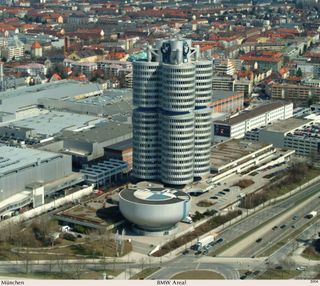
Munich has the strongest economy of any German city and the lowest unemployment rate (5.6%) of any German city with more than a million people (the other ones being Berlin, Hamburg and Cologne). The city is also the economic centre of southern Germany. The initiative “Neue Soziale Marktwirtschaft (INSM)” (New Social Market Economy) and the “WirtschaftsWoche” (Business Weekly) magazine awarded Munich the top score in their comparative survey for the third time in June 2006. Munich topped the ranking of the magazine “Capital” in February 2005 for the economic prospects between 2002 and 2011 in sixty German cities. Munich is considered a global city and holds the headquarters of Siemens AG (electronics), BMW (car), MAN AG (truck manufacturer, engineering), Linde (gases), Allianz (insurance), Munich Re (re-insurance), and Rohde & Schwarz (electronics). Among German cities with more than 500,000 inhabitants purchasing power is highest in Munich (26,648 euro per inhabitant) as of 2007.
The breakdown by cities proper (not metropolitan areas) of Global 500 cities listed Munich in 8th position in 2009. Munich is also a centre for biotechnology, software] and other service industries. Munich is also the home of the headquarters of many other large companies like the aircraft engine manufacturer MTU Aero Engines, the injection molding machine manufacturer Krauss-Maffei, the camera and lighting manufacturer Arri, the semiconductor firm Infineon Technologies (headquartered in the suburban town of Neubiberg), lighting giant Osram, as well as the German or European headquarters of many foreign companies like McDonald’s and Microsoft.
Munich has significance as a financial centre (second only to Frankfurt), being home of HypoVereinsbank and the Bayerische Landesbank. It outranks Frankfurt though as home of insurance companies like Allianz and Munich Re.
Munich is the largest publishing city in Europe and home to Süddeutsche Zeitung, one of Germany's largest daily newspapers. The city is also the location of the programming headquarters of Germany's largest public broadcasting network, ARD, while the largest commercial network, Pro7-Sat1 Media AG, is headquartered in the suburb of Unterföhring. The headquarters of the German branch of Random House, the world's largest publishing house, and of Burda publishing group are also in Munich.
The Bavaria Film Studios are located in the suburb of Grünwald. They are one of Europe's biggest and most famous film production studios.
Transportation
Munich International Airport
Franz Josef Strauss International Airport (IATA: M U C, ICAO: EDDM) is the second-largest airport in Germany and -largest in Europe after London Heathrow, Paris Charle de Gaulle, Frankfurt, Amsterdam, Madrid and İstanbul. It is used by about 34 million passengers a year, and lies some 30 km north east of the city centre. The airport can be reached by suburban train lines S8 from the east and S1 from the west of the city. From the main railway station the journey takes 40–45 minutes. An express train will be added that will cut down travel time to 20–25 minutes with limited stops on dedicated tracks. A magnetic levitation train (called Transrapid) which was to have run at speeds of up to 400 km/h from the central station to the airport in a travel time of 10 minutes had been approved, but was cancelled in March 2008 because of cost escalation and after heavy protests. Lufthansa opened its second hub at the airport when Terminal 2 was opened in 2003.
The airport began operations in 1992, replacing the former main airport, the Munich-Riem airport (active 1939–1992).
Other airports
In 2008, the Bavarian state government granted a license to expand Oberpfaffenhofen Air Station located west of Munich, for commercial use. These plans were opposed by many residents in the Oberpfaffenhofen area as well as other branches of local Government, including the city of Munich, which took the case to court. However, in October 2009, the permit allowing up to 9725 business flights per year to depart from or land at Oberpfaffenhofen was confirmed by a regional judge.
Despite being 110 kilometres from Munich, Memmingen Airport has been advertised as Airport Munich West. After 2005, passenger traffic of nearby Augsburg Airport was relocated to Munich Airport, leaving the Augsburg region of Bavaria without an air passenger airport within close reach.
Public transportation
For its urban population of 2.6 million people, Munich and its closest suburbs have one of the most comprehensive and punctual systems in the world, incorporating the Munich U-Bahn (underground railway), the Munich S-Bahn (suburban trains),Tramtrains and buses. The system is supervised by the Transport and Tarif Association (Münchner Verkehrs- und Tarifverbund GmbH). The Munich tramway is the oldest existing public transportation system in the city, which has been in operation since 1876. Munich also has an extensive network of bus lines.
The extensive network of subway and tram lines assist and complement pedestrian movement in the city centre. The 700m-long Kaufinger Strasse, which starts near the Main train station, forms a pedestrian east-west spine that traverses almost the entire centre. Similarly, Weinstrasse leads off northwards to the Hofgarten. These major spines and many smaller streets cover an extensive area of the centre that can be enjoyed on foot and bike. The transformation of the historic area into a pedestrian priority zone enables and invites walking and biking by making these active modes of transport comfortable, safe and enjoyable. These attributes result from applying the principle of "filtered permability" which selectively restricts the number of roads that run through the centre. While certain streets are discontinuous for cars, they connect to a network of pedestrian and bike paths which permeate the entire centre. In addition, these paths go through public squares and open spaces increasing the enjoyment of the trip(see image). The logic of filtering a mode of transport is fully expressed in a comprehensive model for laying out neighbourhoods and districts—the Fused Grid.
The main railway station is Munich Hauptbahnhof, in the city centre, and there are two smaller main line stations at Pasing, in the west of the city, and Munich Ostbahnhof in the east. All three are connected to the public transport system and serve as transportation hubs.
ICE highspeed trains stop at Munich-Pasing and Munich-Hauptbahnhof only. InterCity (IC) and EuroCity (EC or RJ) trains to destinations east of Munich also stop at Munich East. Since 28 May 2006 Munich has been connected to Nuremberg via Ingolstadt by the 300 km/h (186 mph) Nuremberg–Munich high-speed railway line.
The trade fair transport logistic is held every two years at the Neue Messe München (Messe München International).
Individual transportation
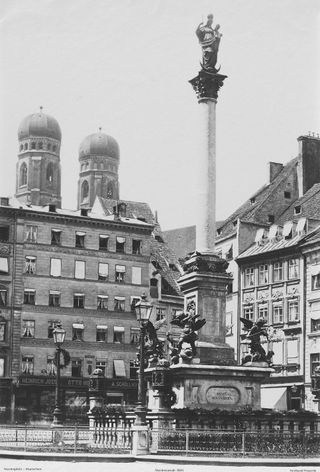
Munich is an integral part of the motorway network of southern Germany. Motorways from Stuttgart (W), Nuremberg, Frankfurt and Berlin (N), Deggendorf and Passau (E), Salzburg and Innsbruck (SE), Garmisch Partenkirchen (S) and Lindau (SW) terminate at Munich, allowing direct access to the different parts of Germany, Austria and Italy. However, traffic in and around Munich is often heavy. Traffic jams are commonplace during rush hour and at the beginning and end of major holidays in Germany.
Cycling
Cycling is recognized as a good alternative to motorized transport and the growing number of bicycle lanes are widely used throughout the year. They are mostly not segregated from pedestrian paths, making them dangerous to both parties. They are also often of low quality surfacing, being partly destroyed by the roots of trees planted between them and the road beside it; the road is rarely so affected. The narrow paths which are usually longer than the road due to many detours around objects, coupled with the presence of pedestrians, make the cycle network useful only to very slow riders.
A modern bike hire system is available in the central area of Munich that is surrounded by the Mittlerer Ring ring road.
Around Munich
The Munich agglomeration sprawls across the plain of the Alpine foothills comprising about 2.6 million inhabitants. Several smaller traditional Bavarian towns and cities like Dachau, Freising, Erding, Starnberg, Landshut and Moosburg are today part of the Greater Munich Region, formed by Munich and the surrounding districts, making up the Munich Metropolitan Region, which has a population of about 4.5 million people.
- Schloss Neuschwanstein Castle, "New Swanstone Castle" (how to visit)
International relations
Munich is twinned with the following cities (date of agreement shown in parentheses)
- Edinburgh, Scotland (1954)
- Verona, Italy (1960)
- Bordeaux, France (1964)
- SapporoW, Japan (1972)
- Cincinnati, Ohio, United States (1989)
- Kiev, Ukraine (1989)
- HarareW, Zimbabwe (1996)
- Munich, München is also the name of other locations, look for: München (Begriffsklärung)
- Etymology (Stadtname)
Famous people
Born in Munich
|
|
Famous residents
|
|
References
- ↑ [1] Mercer Human Resource Consulting
- ↑ 2007 Cost of Living Report Munich Mercer Human Resource Consulting
- ↑ http://www.munichsl.com/ Munich in SL
- ↑ [2]
-
External links
- Munich Tourist Office – up-to-date information for visitors
- national geographic STORIES - all about Munich (Laurel Robbins)
- Discover the Best of Munich — Ten must-do activities in Munich (national geographic)
- Münchner Verkehrs- und Tarifverbund – public transport network
- On the brink: Munich 1918–1919
- Munichfound – magazine for English speaking Münchners
- Destination Munich – (An online guide by Stuart Anderson, Au)
- Munich Airport – Official Website Franz Josef Strauss Airport
- Photos
- Europe Pictures – Munich
- Geocoded Pictures of Munich
- Munich City Panoramas – Panoramic Views and virtual Tours
- Globosapiens Travel Community – Travel Tips
- Tales from Toytown – Photos of Munich
- Munich photo gallery
- Book
- very simple, easy to read
- Rüdiger_Liedtke - 111 Places in Munich That You Shouldn’t Miss (edition)
Source (am-en-fr)
Dieser Artikel basiert auf dem Artikel Munich (München in Englisch) aus der Wikipedia. Die Liste der bisherigen Autoren befindet sich in der Versionsliste. Wie im München-Wiki stehen alle Texte der Wikipedia unter der GNU Freie Dokumentationslizenz, die eine Weiterverwendung unter erleichterten Bedingungen ermöglicht. (in ihrer englischsprachigen Ausgabe mit dem Textbestand vom Mai 2013)
Munich - französisch ausgesprochen
- Siehe bei WP: fr.wikipedia... Munich
… and
- Munich in der Wikipedia auf vereinfachtem Englisch (Simple English)
- Munich bei wikivoyage.org
- munich.world-guides.com
- Munich Fast Facts
[[Kategorie:Stadt München|*
